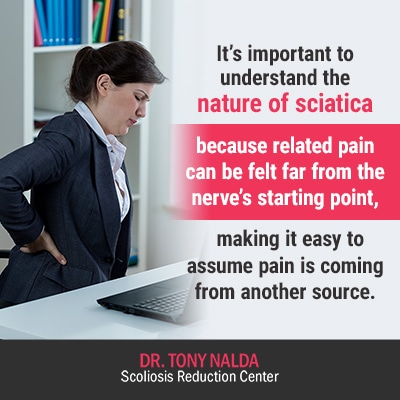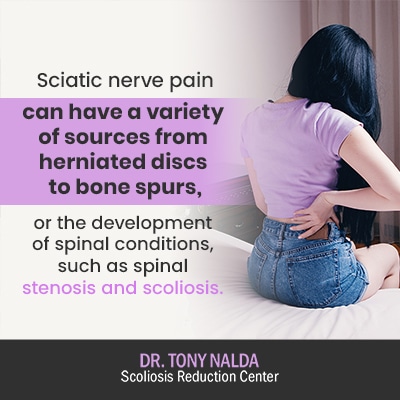Nerves are like branches on a tree, fanning off in multiple directions. If the lower back’s sciatic nerve is exposed to uneven pressure and compression, it can cause pain not only at the nerve’s site of origin, in the lower back, but also down the buttocks, the back of the legs, and into the feet. Sciatic nerve pain can be relieved by addressing its underlying cause and working towards relieving sciatic nerve pressure.
The sciatic nerve starts in the lower back and extends down the buttocks, back of the legs, and to the feet. If the sciatic nerve is compressed, lower back and radiating pain throughout the lower body can develop. Proactive treatment that addresses the underlying cause can lead to pain relief.
Before discussing the specifics of how to proactively address sciatic nerve pain, let’s first explore the topic of sciatica generally.
Understanding Sciatica
Most of us have heard complaints of sciatica, but what exactly is sciatica, and what causes related pain?
The sciatic nerve is extensive, traversing the lower body, so when the sciatic nerve is exposed to adverse tension, pressure, and/or compression, it can produce pain felt in areas of the body through which it travels and reaches: the lower back, buttocks, back of the legs (most commonly the left leg), and the feet.
In addition, sciatica can also cause feelings of tingling and/or numbness felt along the sciatic nerve’s pathway.

It’s important to understand the nature of sciatica because related pain can be felt far from the nerve’s starting point, making it easy to assume pain is coming from another source.
For example, if someone is experiencing shooting nerve pain in the feet, they could assume it’s a foot problem, but in reality, the source of the pain could be the sciatic nerve.
So what types of issues and/or medical conditions can cause sciatica to develop?
Causes of Sciatic Nerve Pain
Sciatic nerve pain can be caused by a number of issues, so let’s take a look at some common causes of sciatica.
Sciatic nerve pain can have a variety of sources from herniated discs to bone spurs, or the development of spinal conditions such as spinal stenosis and scoliosis.
The spine’s intervertebral discs perform many important functions and have a tough and durable outer layer (the annulus) and a soft gel-like interior (the nucleus).
As the spinal discs sit between adjacent vertebrae (bones of the spine), they provide cushioning so the vertebrae don’t rub up against one another and create friction during movement.
The discs also help facilitate vertebral movement and act as the spine’s shock absorbers so stress and weight is distributed evenly along the spine and no one section is exposed to uneven wear.
The discs help the spine maintain its healthy curves and alignment; when the intervertebral discs start to deteriorate either due to natural aging, the cumulative effect of negative lifestyle choices, or the development of a spinal condition, spinal biomechanics are disrupted, impacting the spine’s overall health and function.
Also referred to as ‘slipped’, ‘ruptured’, or ‘bulging’, a disc that becomes herniated means a fragment of the nucleus has pushed through a tear or rupture in the annulus and is protruding into the spinal canal.
As the space within the spinal canal is limited, the displacement of the herniated-disc fragment can press on surrounding nerves and produce varying levels of pain.
Particularly in cases where discs of the lower back become herniated, which is common, as the lumbar spine is where the sciatic nerve begins, the protruding nucleus fragment can expose the nerve to uneven pressure and cause sciatic nerve pain.
It’s quite common that herniated discs indicate the early stages of disc degeneration; once the intervertebral discs start to deteriorate, the spine can become misaligned and is more vulnerable to injury and the development of a variety of spinal conditions.
Spinal bone spurs are overgrowths of bone on the vertebrae. Bone spurs are commonly associated with aging, but spinal conditions such as osteoarthritis or degenerative disc disease (DDD) can also be the cause.
Bone spurs can pinch the sciatic nerve, causing varying levels of pain along the sciatic nerve’s pathway: most commonly down the lower back, buttocks, back of the legs, and the feet.
Spinal Stenosis
Spinal stenosis can happen in any section of the spine, but is most common in the lower back: where the sciatic nerve starts.
Lumbar spinal stenosis involves a narrowing of the spinal canal (tunnel formed by the vertebrae) of the lower back. When the spinal canal is narrowed, there is less room for the spinal cord (bundle of nerves), and this exposes the nerves to uneven forces and pressure.
If spinal stenosis is an issue, the narrowing of the spinal canal can cause the sciatic nerve to become compressed and sciatica to develop.
Scoliosis
If a person has scoliosis, this means they have an abnormal sideways spinal curvature, with rotation, of a certain size: Cobb angle measurement of 10+ degrees.
While not everyone with scoliosis will automatically develop sciatica, it is a common related complication.

As scoliosis involves an unnatural spinal curvature, it introduces a lot of uneven forces to the spine and its surroundings, including the nerves. As scoliosis is progressive, its very nature is to worsen over time, especially if left untreated, or not treated appropriately.
Scoliosis can develop in any section of the spine, and particularly in cases of lumbar scoliosis, it’s more likely that the sciatic nerve will be adversely affected by the scoliotic curve.
While every case of scoliosis is different, generally speaking, the higher the Cobb angle, the more severe the condition is, and the more likely it is to cause related complications such as sciatica.
Here at the Scoliosis Reduction Center®, I treat related sciatic nerve pain by designing a treatment plan that addresses its underlying cause. As sciatic nerve pain is commonly regarded as one of the most debilitating types of back pain, pain management is factored into the treatment process.
While there are never treatment guarantees, my end goal with every patient is to work towards improvements that will improve their quality of life. When it comes to scoliosis and related complications such as sciatic nerve pain, I want to impact the condition in such a way that treatment results are sustainable and help prevent them from experiencing the challenges associated with progression and increasing condition severity.
How Do I Get My Sciatic Nerve to Stop Hurting?
Anyone who has suffered from back pain, whether related to a spinal condition or not, knows how debilitating and disruptive it can be to daily life.
When it comes to sciatic nerve pain, every case is different, and related pain levels will vary based on a number of important patient and condition characteristics such as age and the underlying cause of the sciatica.
Sciatic nerve pain can affect the back, legs, feet, and also cause feelings of tingling and/or numbness in the lower body. Over time, particularly if left untreated, it can also lead to mobility issues.
As scoliosis is my main area of expertise, let’s focus on scoliosis-related sciatica and how it’s addressed here at the Center.
Again, while every case is different, many patients who are living with scoliosis and related sciatic nerve pain also face mobility issues that can impact quality of life in a significant way.
Just as my approach to treating scoliosis is proactive and effective by addressing its underlying structural nature, treating scoliosis-related sciatic nerve pain also has to involve crafting a comprehensive treatment plan that gets to the root of the problem: the uneven forces that scoliosis introduces to the spine and the sciatic nerve.
For those on the traditional medical route for treating sciatic nerve pain, often medication for pain management is the main focus; however, that is only addressing a ‘symptom’ of sciatica, and not the underlying cause of the sciatica itself.
In addition, certain stretches and yoga poses can help, particularly with short-term pain relief, but this also does not address the underlying cause.
When it comes to looking for a source of immediate sciatic nerve pain relief, here at the Center, I can offer specific home exercises, stretches, and spinal rehabilitation that can relieve pressure on the sciatic nerve, but I don’t just want to provide immediate relief; I want to provide long-term relief by addressing its root cause.
When designing treatment plans for scoliosis, no two plans will ever be the same because they are 100-percent customized to address the specifics of the patient and their condition.
If a lumbar scoliosis patient is suffering from sciatica, I will use a variety of therapies to help provide relief, while integrating those disciplines into a treatment plan that also relies on scoliosis-specific chiropractic adjustments, and other forms of treatment, to address the condition on a structural level.
Through an integrative approach combining scoliosis-specific treatment disciplines such as in-office therapy, custom-prescribed home exercises, chiropractic care, and corrective bracing, scoliosis, along with any related complications such as sciatica, can be addressed and treated proactively, before the condition progresses.
Conclusion
When it comes to sciatic nerve pain, there are many potential causes. From disc deterioration to bone spurs, spinal stenosis and scoliosis, the function and overall health of the spine can affect the body in a number of ways.
If sciatica is left untreated, particularly if its cause is related to a progressive spinal condition like scoliosis, the condition can worsen over time and lead to future mobility issues.
As the sciatic nerve starts in the lower back and its pathway extends down the buttocks, the back of the legs, and to the feet, if the nerve is pinched, it can cause pain felt anywhere along that pathway.
It’s important to understand the nature of radiating pain as it can be felt far from its point of origin, making it difficult for people to determine its source.
When sciatica is caused by the uneven pressure introduced to the spine and its surroundings by scoliosis, in order to provide long-term pain relief, the root cause of sciatica, the scoliosis itself, has to be addressed proactively.
Here at the Scoliosis Reduction Center®, I approach treatment for a number of spinal conditions by acknowledging the difference between treating a condition’s symptom, or the actual condition itself; this is an important distinction to understand because while traditional treatment can offer medication for immediate pain relief, it will do nothing to address the structural nature of scoliosis, which is the underlying cause of related sciatic nerve pain.
Through a variety of scoliosis-specific therapies, custom-prescribed exercises, corrective bracing, and focused chiropractic adjustments, sciatic nerve pain can be proactively addressed while the condition at the root of its development is being treated effectively on a structural level.
If you, or someone you care about, is experiencing any of the aforementioned sciatica symptoms, proactive treatment that addresses the condition’s underlying cause is always the best choice, particularly in terms of preventing worsening symptoms.





